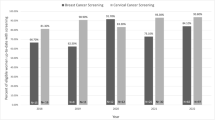Abstract
Women who lack health insurance have much lower rates of cervical cancer screening and higher rates of cervical cancer than insured women. The current screening rate for insured patients is 86.9%, while the rate for uninsured women is 68.2%. Student-run free clinics may help increase the rates of cervical cancer screening in uninsured women. As screening rates in this setting are uncertain, this study was performed to determine rates of cervical cancer screening at a student-run free clinic, and therefore determine its effectiveness in increasing screening rates in uninsured women. A retrospective chart review was conducted among female patients ages 21–64 at a student-run free clinic to determine how many patients were up-to-date with cervical cancer screening per American Cancer Society (ACS) guidelines. A total of 239 women were included in the retrospective chart review. At their most recent visit, 87.9% of clinic patients were up-to-date on cervical cancer screening. This screening rate is higher than both the reported uninsured (68.2%) and insured (86.9%) national screening rates in the United States. Although there are multiple barriers that prevent uninsured patients from undergoing cervical cancer screenings, screening rates at our student-run free clinic are higher than national screening rates. This higher screening rate can be attributed to a standardized screening system, access to resources including Pap tests provided by community partners, and the clinic’s ability to longitudinally follow patients. However, there remain areas for improvement, such as reducing no-show rates and ensuring that staff screen for cervical cancer at each visit.


Similar content being viewed by others
References
CDC. (2019). Health, United States, 2015. Table 19. Retrieved June 12, 2019 from www.cdc.gov/nchs/data/hus/2015/019.pdf.
National Institutes of Health. (2019). Cervical Cancer. Retrieved June 12, 2019 from https://report.nih.gov/nihfactsheets/viewfactsheet.aspx?csid=76.
Akinlotan, M., Bolin, J. N., Helduser, J., Ojinnaka, C., Lichorad, A., & Mcclellan, D. (2017). Cervical cancer screening barriers and risk factor knowledge among uninsured women. Journal of Community Health,42(4), 770–778.
Niu, X., Roche, L. M., Pawlish, K. S., & Henry, K. A. (2013). Cancer survival disparities by health insurance status. Cancer Medicine,2(3), 403–411.
Fedewa, S. A., Cokkinides, V., Virgo, K. S., Bandi, P., Saslow, D., & Ward, E. M. (2012). Association of insurance status and age with cervical cancer stage at diagnosis: National Cancer Database, 2000–2007. American Journal of Public Health,102(9), 1782–1790.
Akers, A. Y., Newmann, S. J., & Smith, J. S. (2007). Factors underlying disparities in cervical cancer incidence, screening, and treatment in the United States. Current Problems in Cancer,31(3), 157–181.
American Cancer Society. (2019). The American Cancer Society guidelines for the prevention and early detection of cervical cancer. Retrieved June 15, 2019 from https://www.cancer.org.
Watson, M., Benard, V., King, J., Crawford, A., & Saraiya, M. (2017). National assessment of HPV and Pap tests: Changes in cervical cancer screening, National Health Interview Survey. Preventive Medicine,100, 243–247.
Healthy People. (2020). Office of disease prevention and health promotion. Washington, DC: US Department of Health and Human Services. Retrieved June 15, 2019 from http://www.healthpeople.gov/2020/topics-objectives/topic/cancer/objectives.
Acknowledgements
We would like to thank the sponsors of BRIDGE Clinic and our partners for their generous donations that allow us to provide Pap smears and HPV testing to our patients.
Author information
Authors and Affiliations
Corresponding author
Ethics declarations
Conflicts of interest
The authors have no conflicts of interest to disclose.
Additional information
Publisher's Note
Springer Nature remains neutral with regard to jurisdictional claims in published maps and institutional affiliations.
Rights and permissions
About this article
Cite this article
Price, C.R., Hatch, L.A., Radisic, A. et al. Enhancing Adherence to Cervical Cancer Screening Guidelines at a Student-Run Free Clinic. J Community Health 45, 128–132 (2020). https://doi.org/10.1007/s10900-019-00724-8
Published:
Issue Date:
DOI: https://doi.org/10.1007/s10900-019-00724-8




